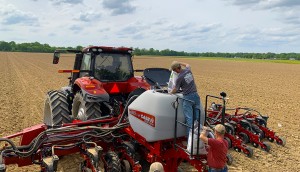My #Plant24 corn went in the ground on May 1, and it was up in just five days. We planted in ideal conditions: soil temperature was 76 degrees, and while the surface was dry, the seeds were placed two inches deep in moist soil. We’ve had nearly 1.5” of rain since. Preplant broadcast applications included our Supers (N,P, K), Sulfur, micronutrients, and Breakout. Right behind the planter, we applied Supers, X-Tend and herbicide, Acuron and Roundup. We’ve had temperatures around 80 degrees. The photo below was taken on May 6.

Biofuels continue to drive corn and soybean markets. And soon, they’ll be used to drive more than cars, trucks and tractors. As the airline industry seeks to decarbonize, Sustainable Aviation Fuel (SAF) is taking flight, offering airlines a means to meet their sustainability goals. Delta Airlines alone consumes nearly 4 billion gallons of jet fuel annually. To further incentivize sustainability in the air, the 2022 Inflation Reduction Act introduced a SAF 40B tax credit. The subsidy program offers SAF producers significant tax credits. SAF that achieves a GHG emissions reduction of 50% is eligible for the $1.25 credit per gallon amount, and SAF that achieves a GHG emissions reduction of more than 50% (based on various sustainably friendly production practices) is eligible for an additional $0.01 per gallon for each percentage point the reduction exceeds 50%, up to an additional $0.50 per gallon. A portion of these incentives will be paid to corn and soybean growers. Last week, new guidance on the GREET (Greenhouse gases, Regulated Emissions, and Energy use in Technologies) model was announced. The updated 40B SAF GREET model – which some believe is a precursor the wider 45Z tax credit that encompasses on-road fuel, and may possibly guide SBTi standards from food companies – evaluates the full fuel lifecycle, which includes all stages from the production of feedstock to the end use of the finished fuel. Corn growers looking to cash-in on the SAF market premiums must implement three specific production practices on the same acreage:
- Cover crops
- No-till (which in the GREET model, includes strip-till)
- Enhanced efficiency fertilizers
Meanwhile, soybean growers are only expected to adopt cover crops and no-till, presumably since they don’t rely on nitrogen fertilizers. Many corn growers feel the adoption of all three practices will limit market access, as utilizing all three practices may not be practical on certain acres. For Huma, the enhanced efficiency fertilizer inclusion represents a big opportunity. Enhanced efficiency fertilizers are intended to improve nutrient use efficiency, reduce nutrient loss risk, and lower greenhouse gas emissions. They are defined by AAPFCO (Association of American Plant Food Control Officials) as products that uptake and reduce nutrient losses compared to standard fertilizers. These strategies include using nitrification inhibitors, urease inhibitors or slow-release fertilizers for a minimum of 50% of nitrogen applications. By this definition, our humic-based products such as X-Tend and Super Nitro should be eligible. Additionally, since some nitrogen stabilizers are antagonistic to soil microbes, this opens opportunities for microbe-feeding products like Zap.
Related Posts

This Week in Ag #14
You never get a second chance to make a first impression. That popular saying could just as easily apply to planting corn. It’s impossible to recover from planting time mishaps. Don’t believe it? Try this. Walk into a cornfield where plants have recently emerged. Identify a plant that’s shorter than the rest (some call these

This Week in Ag #1
Curly fries, waffle fries, spicy fries or… regen fries? Soon, these may all be choices in the frozen foods aisle, at least if McCain Foods has a say in it. And as the world leader in prepared potato products, purchasing 6.8 million tons of spuds annually, McCain carries a strong voice. Their commitment to sustainability includes a pledge to have regen

This Week in Ag #40
I’ll never forget the sage words an old farmer told me when I announced my intention to start farming in the late 1990s. I explained that I was not leaving my marketing job and that I was also doing a fair amount of freelance consulting work. He told me, “It’s funny how many other jobs you need

